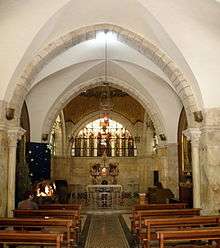Church of the Flagellation
| Church of the Flagellation | |
|---|---|
|
| |
| Basic information | |
| Location | Jerusalem |
| Affiliation | Roman Catholic |
| Architectural description | |
| Architect(s) | Antonio Barluzzi |
| Completed | 1929 |
The Church of the Flagellation is a Roman Catholic church and semi-defunct Christian pilgrimage site located in the Muslim Quarter of the Old City of Jerusalem, near the St. Stephen's Gate. Also included in this complex are the Franciscan Monastery of the Flagellation, and the Church of the Condemnation and Imposition of the Cross.
Tradition

According to tradition the church enshrines the spot where Jesus Christ was flogged by Roman soldiers before his journey down the Via Dolorosa to Calvary. However, this tradition is based on the mistaken assumption that on an area of Roman flagstones, discovered beneath the adjacent Church of the Condemnation and Imposition of the Cross and the Convent of the Sisters of Zion, was the pavement (Greek: lithostratos) which the Bible describes as the location of Pontius Pilate's judgment of Jesus;[1] archaeological investigation now indicates that these slabs are the paving of the eastern of two 2nd century Forums, built by Hadrian as part of the construction of Aelia Capitolina.[2] The site of the Forum had previously been a large open-air pool, the Strouthion Pool, which was constructed by the Hasmoneans, is mentioned by Josephus as being adjacent to the Fortress in the first century,[3] and is still present beneath Hadrian's flagstones.
Like Philo, Josephus testifies that the Roman governors stayed in Herod's palace while they were in Jerusalem,[4] carried out their judgements on the pavement immediately outside it, and had those found guilty flogged there;[5] Josephus indicates that Herod's palace is on the western hill,[6] and it has recently (2001) been rediscovered under a corner of the Jaffa Gate citadel. Archaeologists now therefore conclude that in the first century, the Roman Governors judged at the western hill, rather than the area around the Church of the Flagellation, on the diametrically opposite side of the city.[7]
History
The original structure was built by Duke Maximilian Joseph in Bavaria in 1839 over the remains of a medieval crusader shrine. During the Ottoman period this early shrine and its surrounding buildings were reportedly used as stables, and later as private houses. The whole complex was eventually given to the Franciscans by Ibrahim Pasha of Egypt in the 19th century.
Design and construction
The current church was completed between 1927 and 1929 and was a complete reconstruction of the original shrine. The interior of the church consists of a single aisle. Some noteworthy points of interest include the church's three stained glass windows, each depicting a different aspect of the church's Biblical history, and the church's mosaic-clad golden dome. The first window depicts Pontius Pilate washing his hands, (Matthew 27:24) the second the Flagellation, (Mark 15:15) (John 19:1) and the third the victory of Barabbas. (Matthew 27:26) (Mark 15:15) (Luke 23:24-25) The mosaic of the dome is designed as a crown of thorns. The architect of the churches reconstruction was Antonio Barluzzi. The church is currently held in trust by the Franciscan Custody of the Holy Land.
References
- ↑ John 19:13
- ↑ Pierre Benoit, The Archaeological Reconstruction of the Antonia Fortress, in Jerusalem Revealed (edited by Yigael Yadin), (1976)
- ↑ Josephus, Jewish War 5:11:4
- ↑ Pierre Benoit, The Archaeological Reconstruction of the Antonia Fortress, page 87, in Jerusalem Revealed (edited by Yigael Yadin), (1976)
- ↑ Josephus, Jewish Wars, 2:14:8
- ↑ Josephus, Jewish Wars, 5:2
- ↑ Pierre Benoit, The Archaeological Reconstruction of the Antonia Fortress, in Jerusalem Revealed (edited by Yigael Yadin), (1976)
External links
| Wikimedia Commons has media related to Church of the Flagellation. |
Coordinates: 31°46′49.93″N 35°14′03.72″E / 31.7805361°N 35.2343667°E